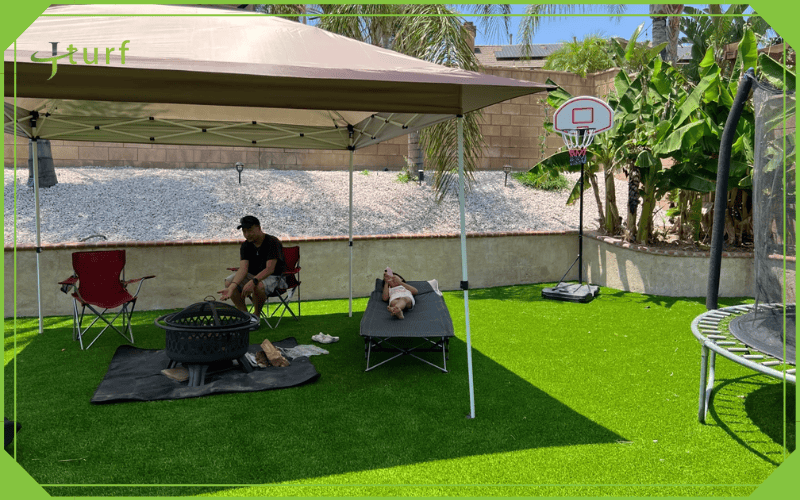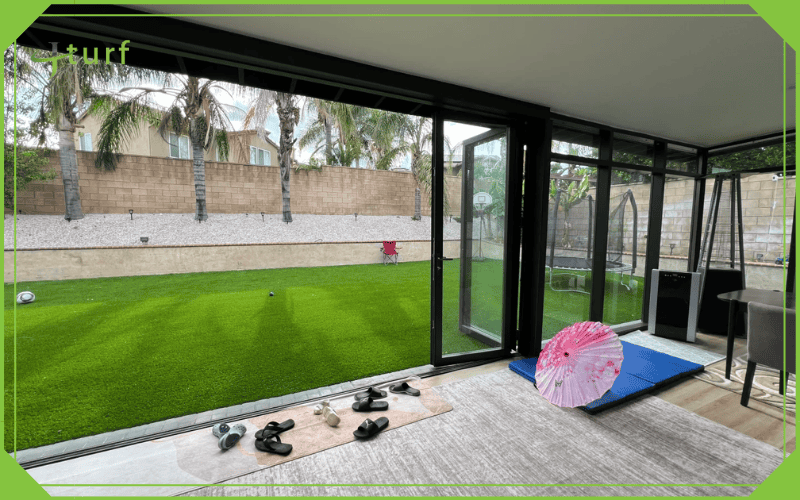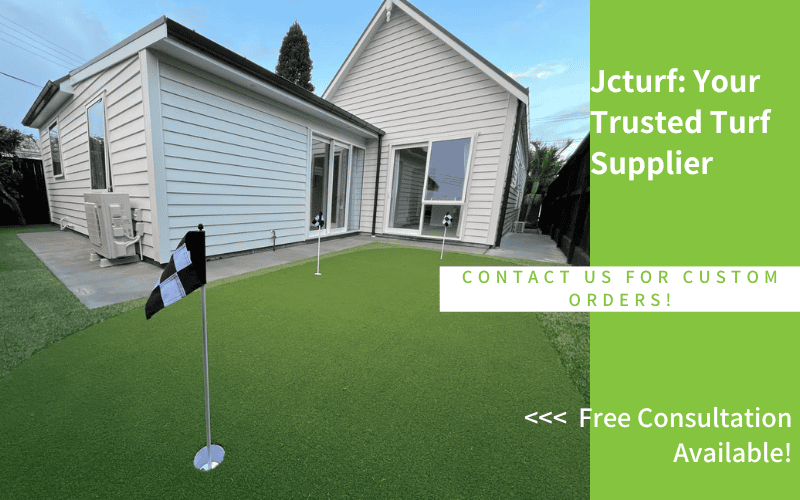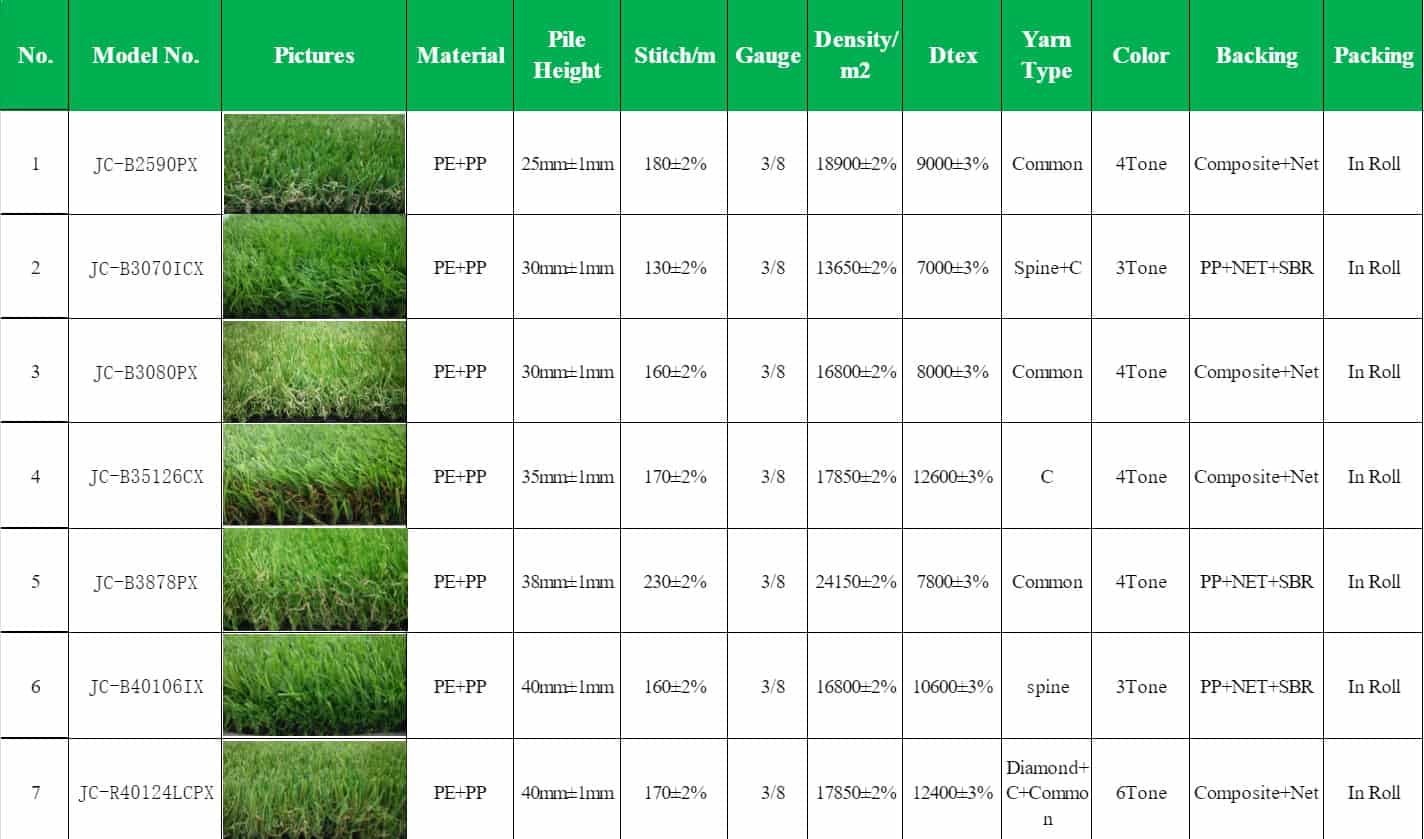Is artificial turf worth it? For a lot of our customers, the answer is yes—but not always for the reasons you’d expect. It’s not about chasing perfection. It’s about finally solving problems real grass couldn’t—mud, mess, constant upkeep, or yards that just won’t grow.
In this guide, we’ve pulled together what homeowners actually say after months or years of living with turf. You’ll hear the good (less maintenance, better curb appeal), the not-so-good (it gets hot, and it’s not 100% hands-off), and the trade-offs that helped people decide if it was right for them.
We’ll also share what we’ve learned across hundreds of projects—like when turf works best, when to think twice, what really affects cost and lifespan, and what separates decent turf from a regret purchase. Finally, we’ll wrap with a clear pros and cons summary to help you make the call with confidence.
Is Artificial Turf Worth It? What Our Customers Say
Whether artificial turf is worth it depends on how—and where—you use it. Over the past few years, we’ve collected feedback from hundreds of turf users—from small-yard homeowners to schools and rental property managers. Their long-term experience reveals where artificial turf shines, where it stumbles, and what trade-offs actually matter.
From how hot it gets in summer to how pets react and how much work it really takes, these firsthand stories cover the highs, the hassles, and the surprises—so you can decide if turf fits your space and lifestyle.

“It Looks Great—But Can Get Hot”
Almost everyone agrees: artificial grass looks amazing. One customer told us, “It’s the only thing in my yard that still looks alive in August.” But once summer hits, the heat becomes hard to ignore.
We’ve heard comments like, “Sometimes it’s fine, but on certain days it feels like you could fry an egg on it.” Shaded spots definitely help, and a quick spray with the hose brings it down. A few customers also mentioned switching to turf made with cooling fibers—which made a difference, but didn’t make it cold.
Bottom line? It looks great, but if you’ve got bare feet or dogs, it’s something to plan around—not something to be surprised by.
“Not Maintenance-Free, But Still Easier Than Real Grass”
A lot of folks go in thinking turf means zero work. That’s not quite how it plays out—but it’s still less hassle than watering, mowing, or trying to save dying grass.
You’ll probably want to hose it off every so often, rake it when it gets matted, and maybe blow away leaves if you’ve got trees nearby. One guy told us, “It takes 10 minutes, unless the dog’s been extra generous that week.”
Another said, “It’s not ‘set it and forget it’—but I’ll take this over yard work any day.” You still need to care for it—but it’s the kind of upkeep that doesn’t take over your weekend.
“Pets Use It Daily—Just Watch for Odor”
“Will my dog use it?” is one of the first things people ask. And in almost every case, the answer’s yes—dogs adapt fast. But some customers warned us: if your pup keeps going in the same corner, you’ll notice.
Regular rinsing helps. So do pet-friendly odor sprays. Still, a few people said they wish they’d installed drainage a bit better or cleaned more often in summer. As one customer put it: “It’s great 90% of the time. But when it’s not… you’ll know.”
Also worth noting—some folks didn’t expect window reflections to melt turf edges. It doesn’t happen to everyone, but it’s happened enough that we now mention it upfront.
“It’s a Big Improvement Over Mud and Holes”
This is probably the single most common reason people go for turf: their real yard just isn’t working. Whether it’s heavy shade, bad drainage, or a dog who loves to dig, they’re tired of the mess.
“I gave up,” one customer told us. “I’d fill in holes and they’d be back in two days. Now I don’t think about it.” Others mentioned how turf finally let their kids play outside without dragging mud into the house.
Is it perfect? Not always. Some folks still deal with leaves or stubborn weeds along the edges. But when your backyard goes from “no-go zone” to “finally usable,” that trade-off tends to feel worth it.
“We Went DIY—And It Paid Off”
Not everyone wants to pay for professional installation—especially for smaller yards. That’s why some of our customers gave DIY a shot. “We kept it under $1,000 and still get compliments,” one person said.
It wasn’t exactly a walk in the park. A few mentioned spending weekends leveling the ground, Googling how to do a drainage layer, or realizing too late they needed more base gravel. But most came away feeling it was doable. Some even found used turf through local resellers or contractors cleaning out inventory.
If you’re handy—or just a little stubborn—it might be worth it. Just expect a learning curve.
“It’s Not Just for Lawns”
Turf doesn’t only belong in the front yard. More and more customers are using it in side alleys, on patios, around pools, even rooftops. One family put it between raised garden beds so they wouldn’t track mud into the kitchen.
Another told us, “I didn’t want a sandbox—I wanted something I could hose off.” One landlord said turf cut their maintenance hours in half between tenants. And a few people who rent apartments mentioned using it to make small balconies feel more livable.
It’s not always about replacing grass—it’s about creating space that works better.
“Not All Turf Feels the Same”
You might think turf is turf—but that’s not what customers tell us. Some find it soft and realistic; others say theirs feels stiff or plasticky, especially in bare feet. Texture and temperature vary more than people expect.
Several mentioned trying samples first, which helped avoid surprises. “The one I almost ordered looked great in photos,” one buyer said, “but in person, it felt like bristles.” Others were surprised by how fast cheaper turf flattened or looked shiny under certain light.
Lesson learned? If you can, touch before you buy. Price matters—but feel matters more.
“Some Worry About Safety—We’ve Upgraded Materials”
Every now and then, a customer—usually a parent or someone with a new puppy—asks us the big one: “Is turf actually safe?” It’s a fair question. A few folks said they’d read online about older products containing lead or giving off smells in the sun.
Most don’t dig too deep, but the ones who do often ask for material info. “I wasn’t planning to ask,” one mom told us, “but once the turf was going where my toddler plays, I needed to know what it was made of.”
All our turf is certified lead-free and tested against modern safety standards—including CE and SGS certifications for toxicity and material safety. Some families even went with our kindergarten-grade turf just for the extra peace of mind.
We usually don’t lead with it—but it’s there when people want to see it.
Our Expert Advice: When Artificial Turf Is Worth It—and When It’s Not
After years of working with turf buyers—from DIY homeowners to schools and property managers—we’ve noticed something: turf is a smart investment in the right setting, and a frustrating one in the wrong. Whether it’s worth it for you depends less on what it is, and more on where and how you plan to use it. Here’s how to tell if artificial grass is likely to be a win—or a letdown.

Best Use Cases for Artificial Turf
If you’ve got a small lawn, live in a dry region, or just want to cut down on maintenance, turf often pays off. Many of our happiest customers have shaded yards where grass won’t grow, or tight city spaces where mowing is more hassle than it’s worth.
It’s also popular in dog runs, pool surrounds, and rental properties—places where durability matters more than perfection. And for low-traffic front yards, turf keeps things looking tidy without the weekend chore list.
In these cases, it’s less about replacing grass and more about solving a problem that real grass never handled well in the first place.
When We Recommend You Think Twice
Turf isn’t perfect for every location. We usually advise caution in areas with strong sun reflection, like yards next to large glass walls or mirrored fences. The concentrated heat can warp turf fibers, and it’s not always easy to fix.
Another red flag? Barefoot toddlers or crawling infants during hot summer months. Even with heat-resistant materials, turf can still get warm enough to be uncomfortable.
Lastly, sloped or uneven yards may require extra prep and anchoring. If you’re not sure about drainage or soil stability, it’s worth pausing before you commit.
Quality and Installation Matter More Than You Think
No matter where you install it, turf is only as good as the material and prep work behind it. Lower-grade turf often flattens quickly, fades in sunlight, or gets too hot to enjoy. We’ve had customers tell us they “saved on the grass but paid double fixing it later.”
Infill choice, drainage layers, and proper leveling make a bigger difference than most people expect. That’s why we always recommend either professional help—or serious DIY prep with a clear plan.
The upfront work isn’t glamorous. But if you get it right, turf does exactly what it’s supposed to: hold up, look good, and stay easy.
Is Artificial Turf a Smart Long-Term Investment?
For many homeowners, artificial turf isn’t just about looks—it’s also about saving time and money. Upfront costs are higher than grass seed, sure. But when you factor in long-term expenses like watering, mowing, fertilizer, and re-sodding, turf often makes financial sense over time.
Most professional installations range from $7 to $15 per square foot. DIY projects can cost less, especially for small areas or reused materials. But either way, it’s a one-time cost—no sprinkler bills, no weekend lawn care.
Some of our customers say they started saving in year three or four. Others simply valued having a yard that stayed clean, green, and low-maintenance. Quality turf typically lasts 8 to 15 years, and there’s even a small resale market for used rolls in good condition.
It’s not a budget choice—but it can be a smart one if you’re in it for the long run.
Pros and Cons of Artificial Turf—Quick Summary
Artificial turf has clear advantages—but it’s not perfect. If you’re still undecided, here’s a quick side-by-side look at what it does well and where it falls short. This isn’t a sales pitch. Just what our customers tell us matters most, after living with turf for years.
| Pros | Cons |
| Low water use—no irrigation needed | Can get hot in direct sun |
| No mowing, fertilizing, or re-seeding | Needs occasional rinsing and brushing |
| Pet- and kid-friendly, year-round use | Texture may feel less natural than real grass |
| Always looks tidy, no patchy spots | Higher upfront cost than natural lawn |
| Long lifespan (8–15 years) | Weeds may appear around the edges over time |
Conclusion: So, Is It Worth It?
In the end, artificial turf isn’t magic—and it’s not for everyone. But for a lot of people, it’s the thing that finally made their yard usable again. The thing that took a weekend chore off their plate. The thing the dog stopped digging through.
Our job isn’t to convince you it’s perfect. It’s to help you figure out if it’s right for your space, your climate, your lifestyle. Because when it fits, it fits—and that’s what makes it worth it.


